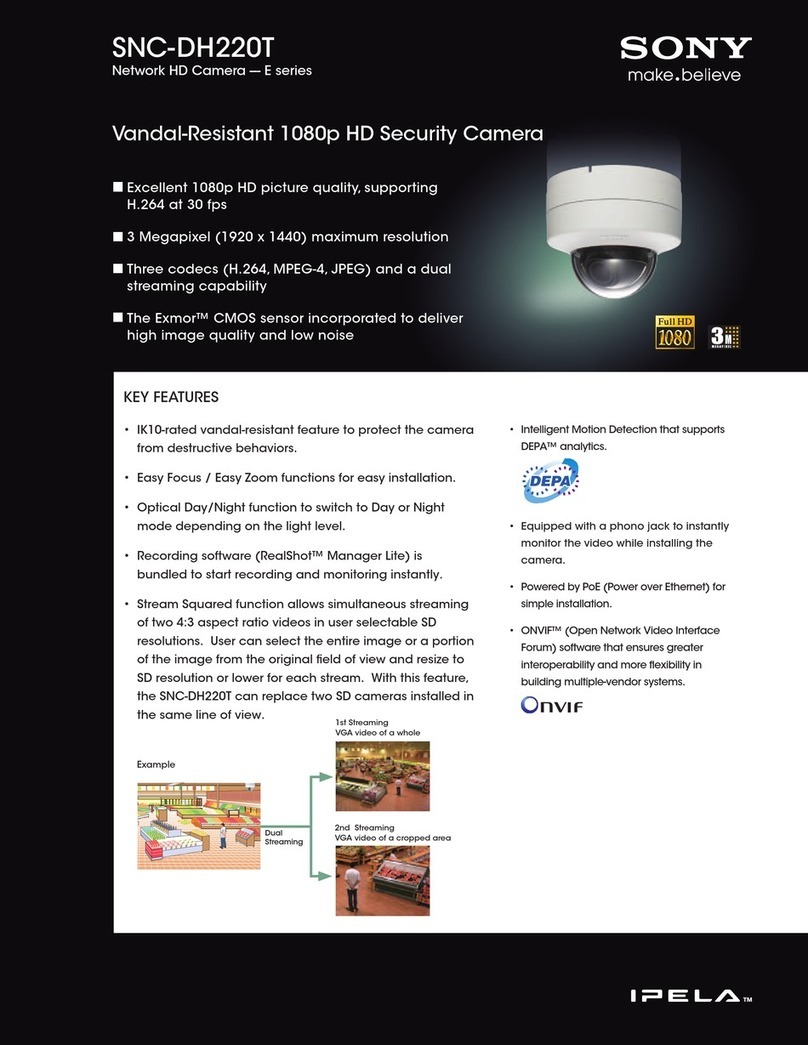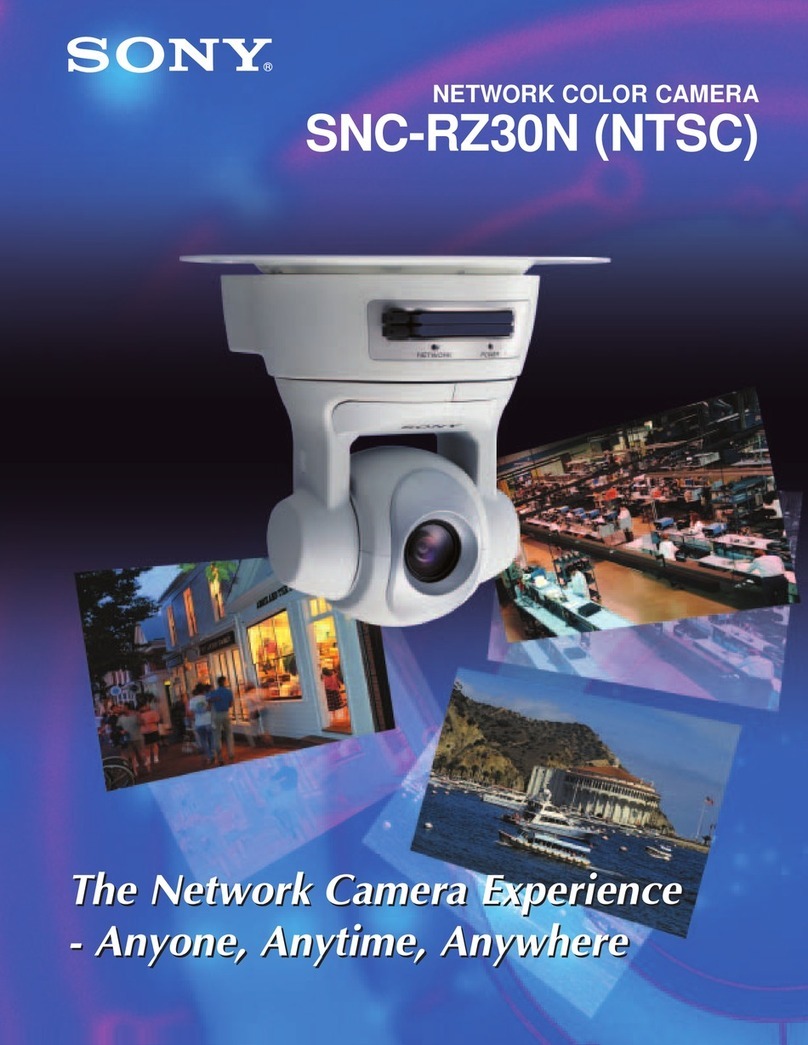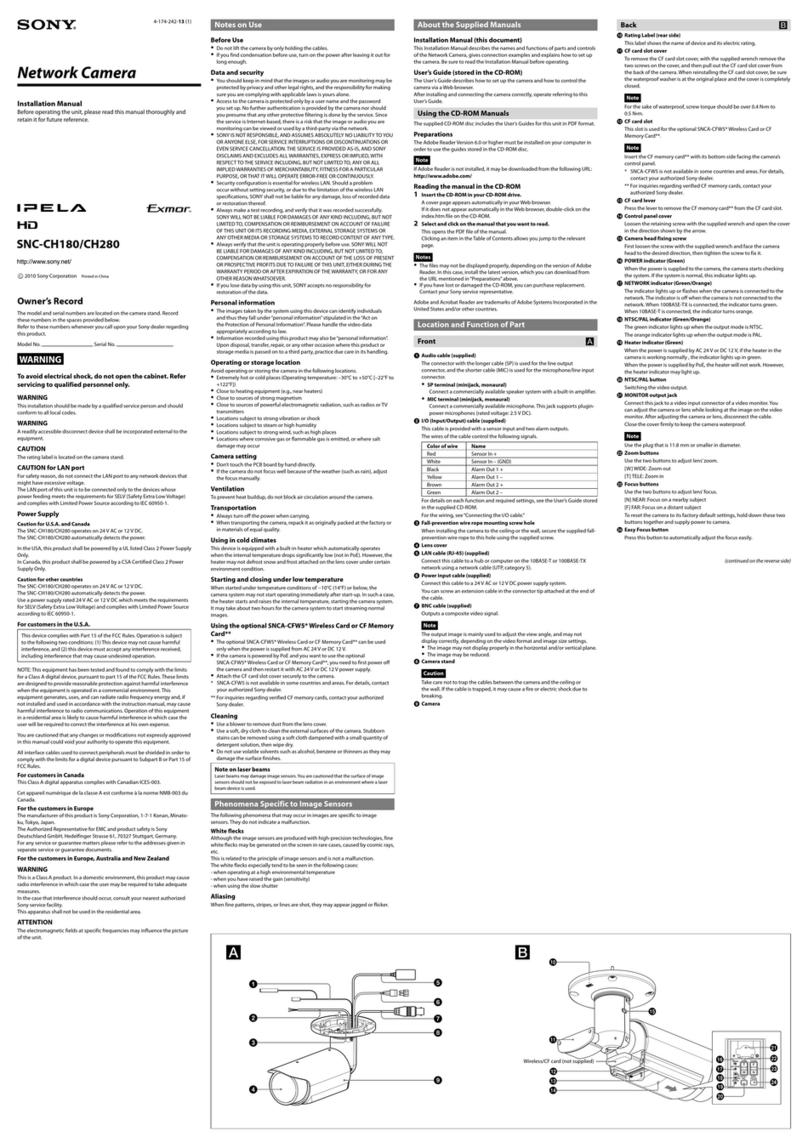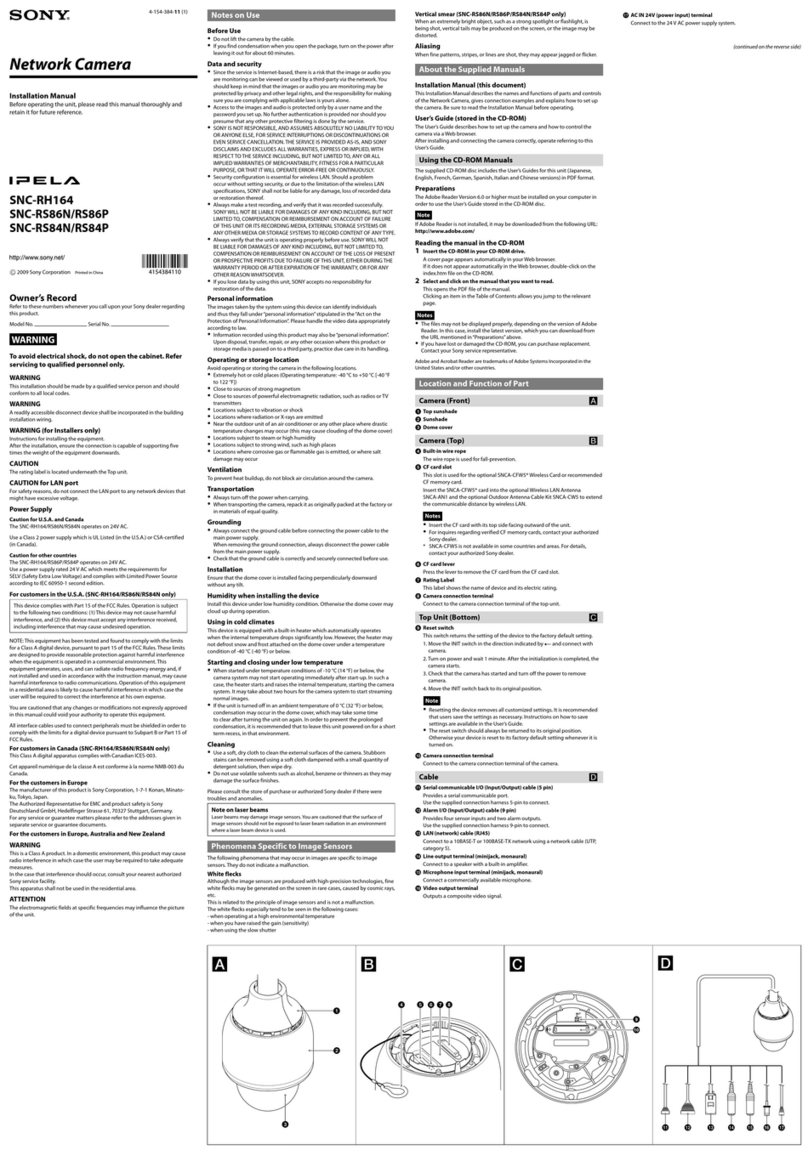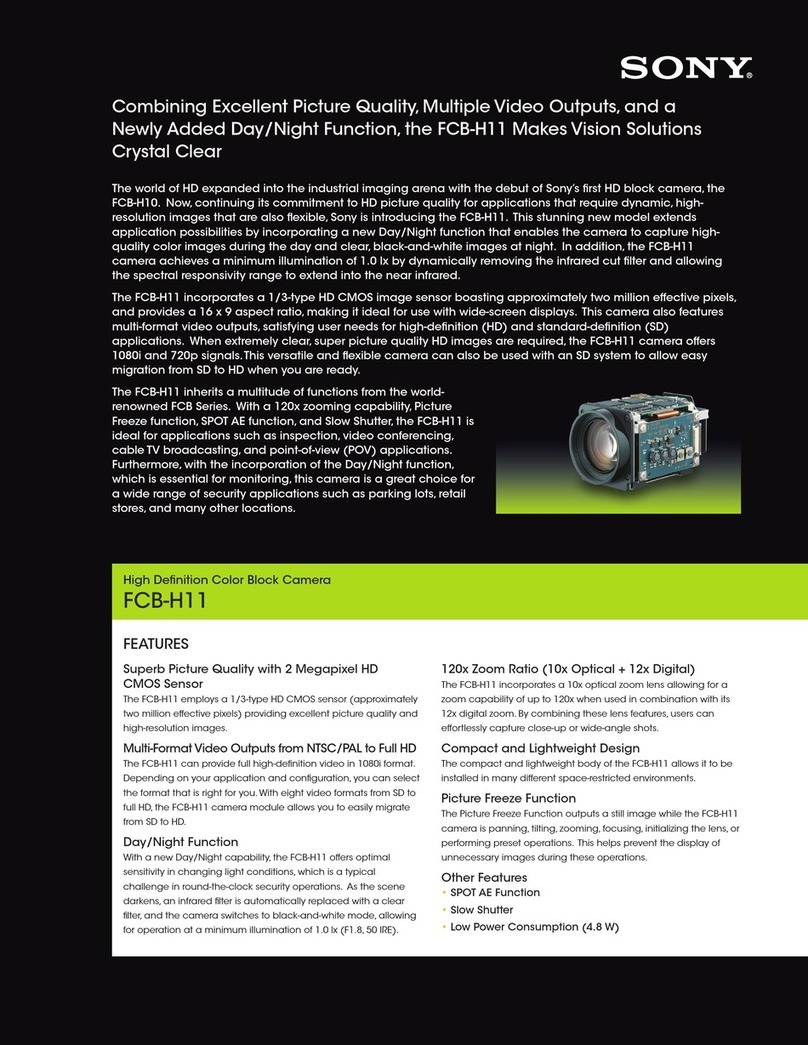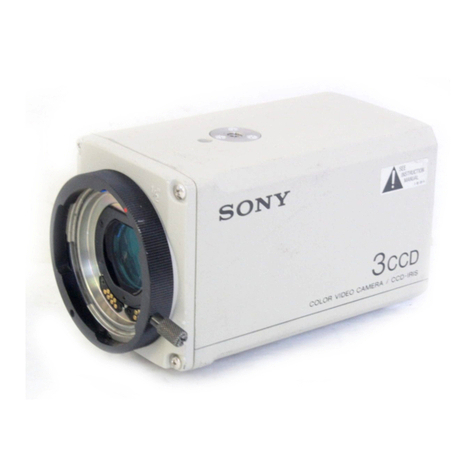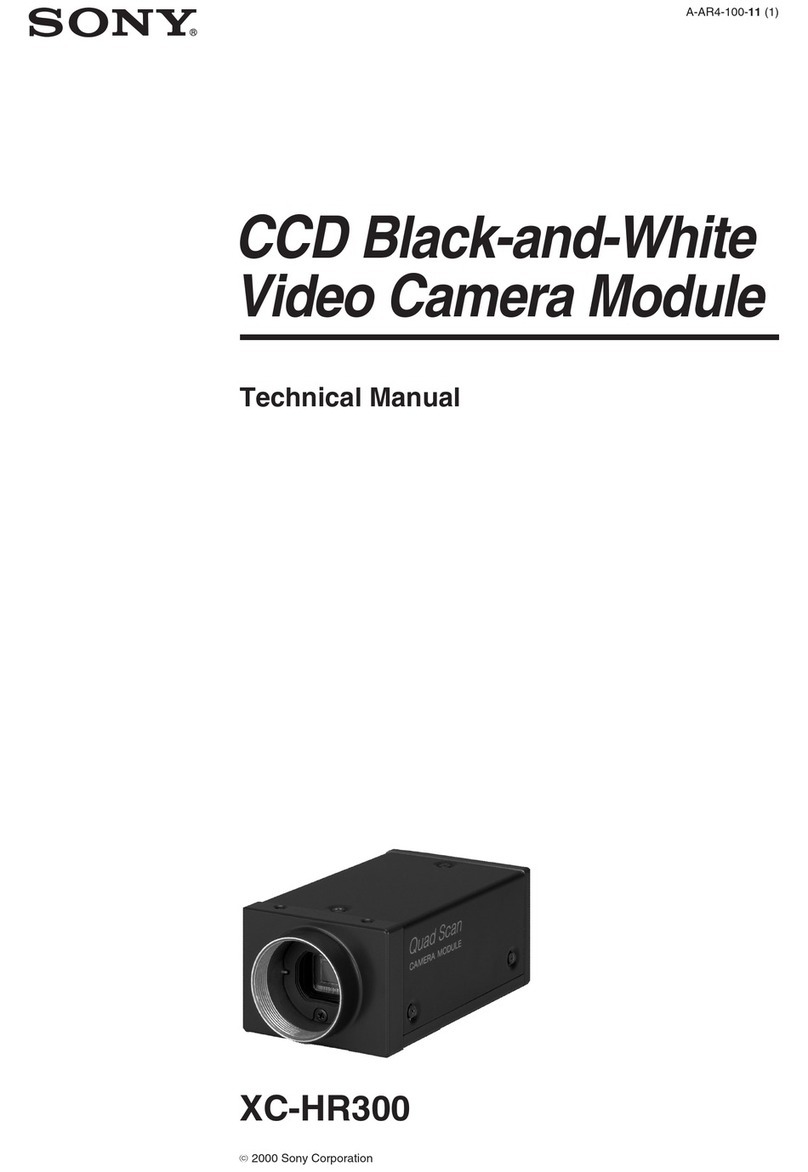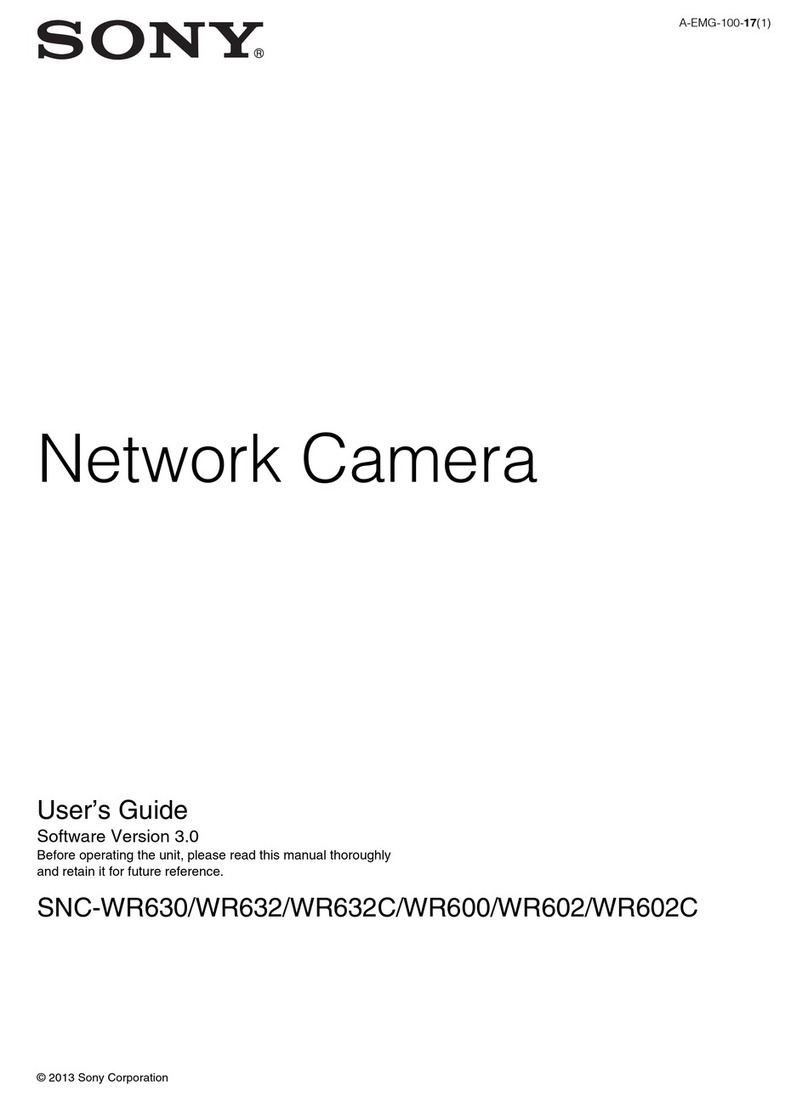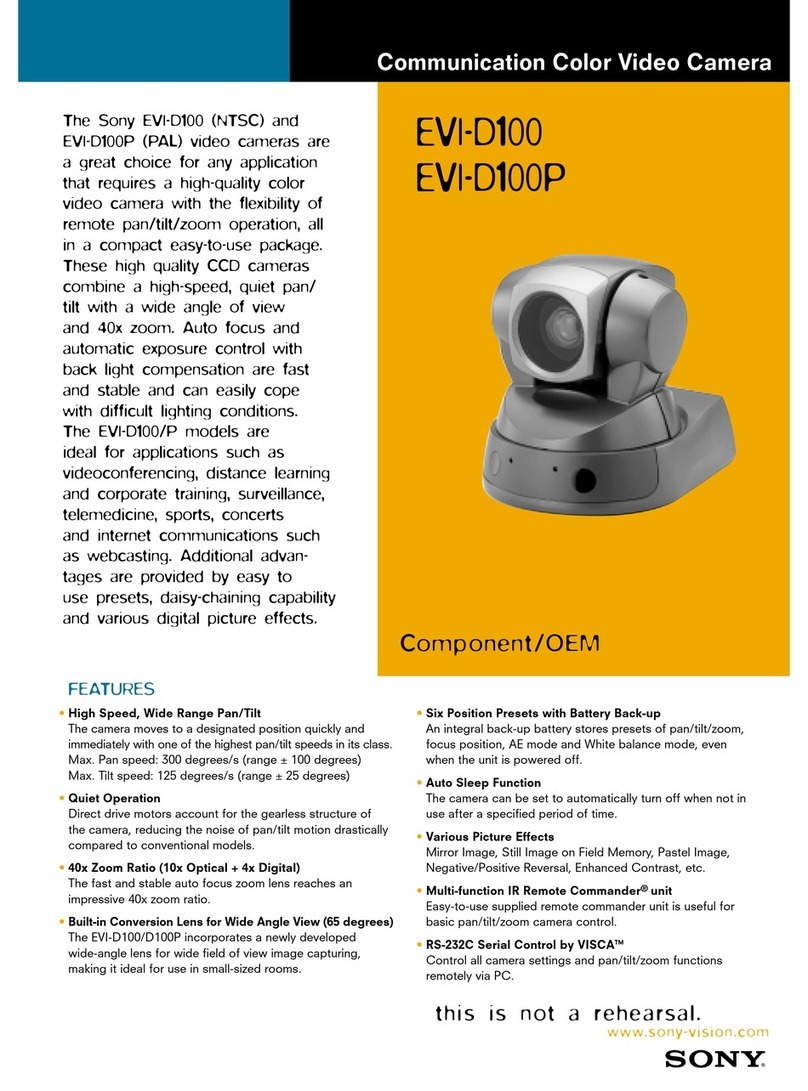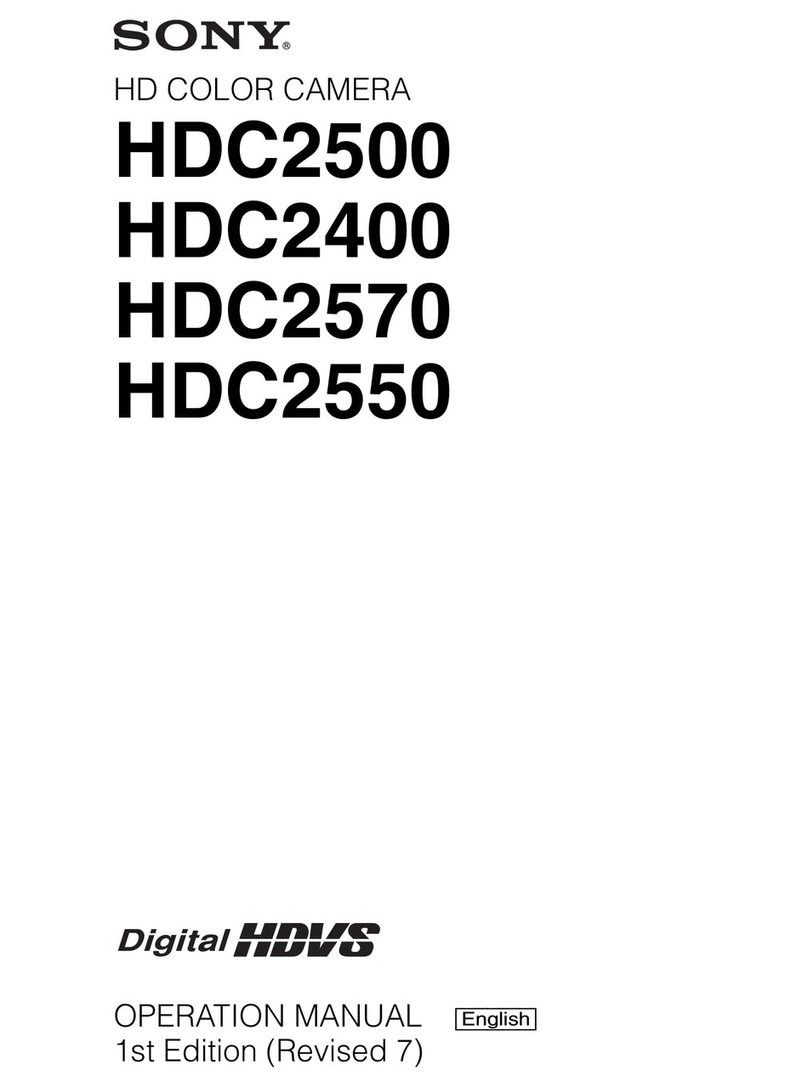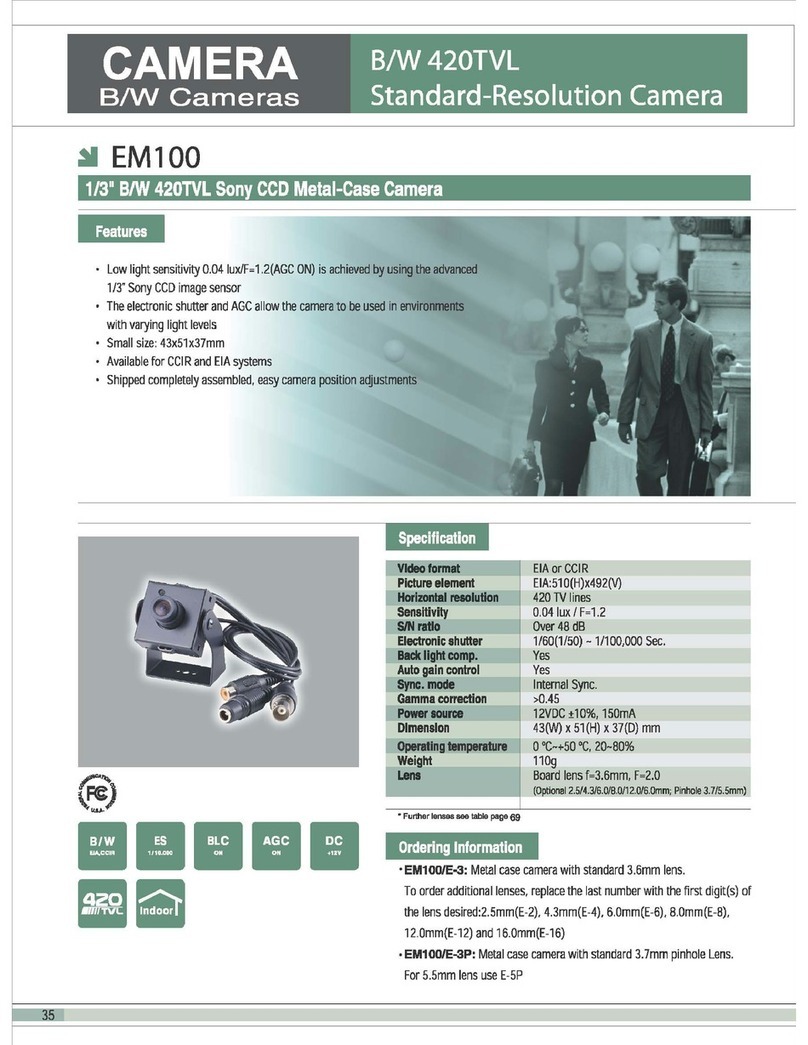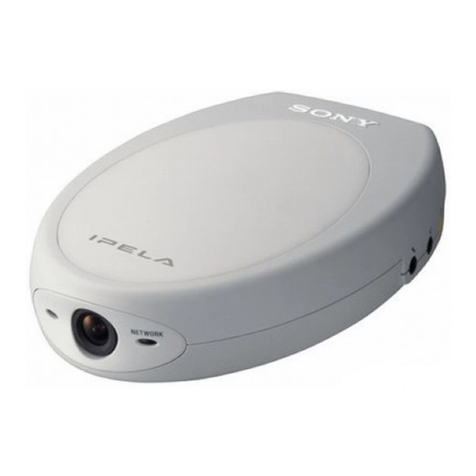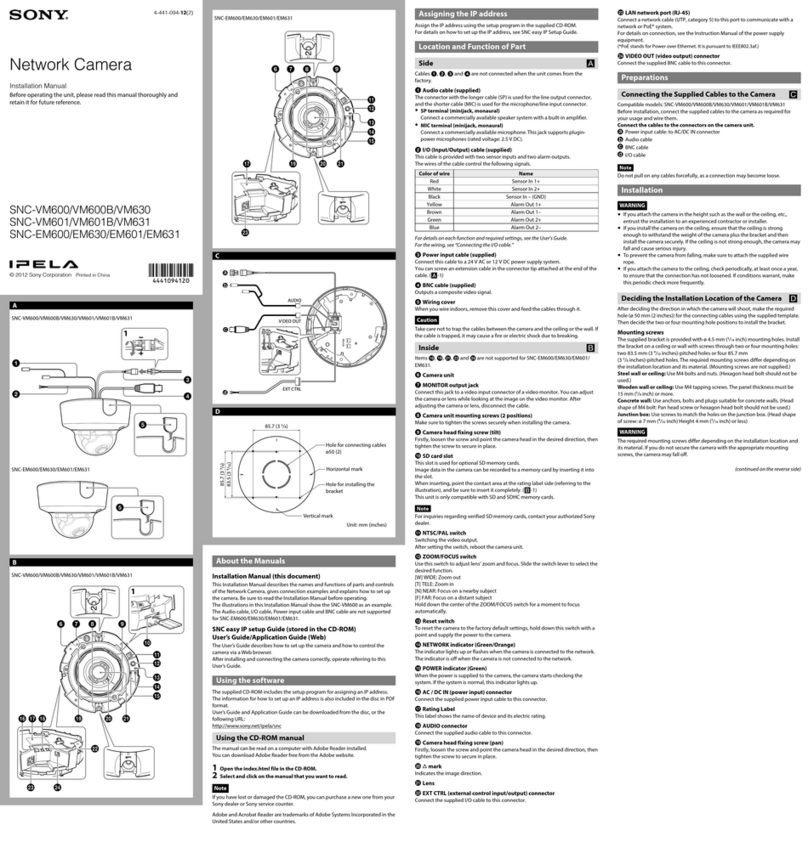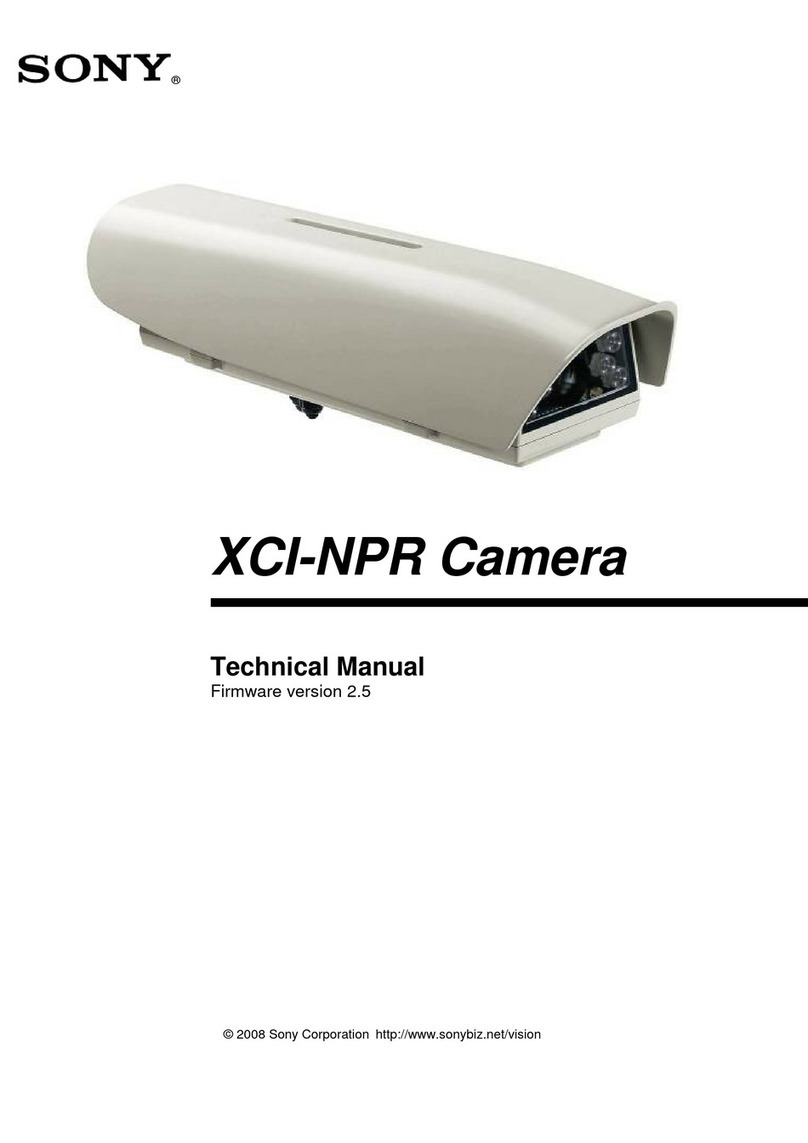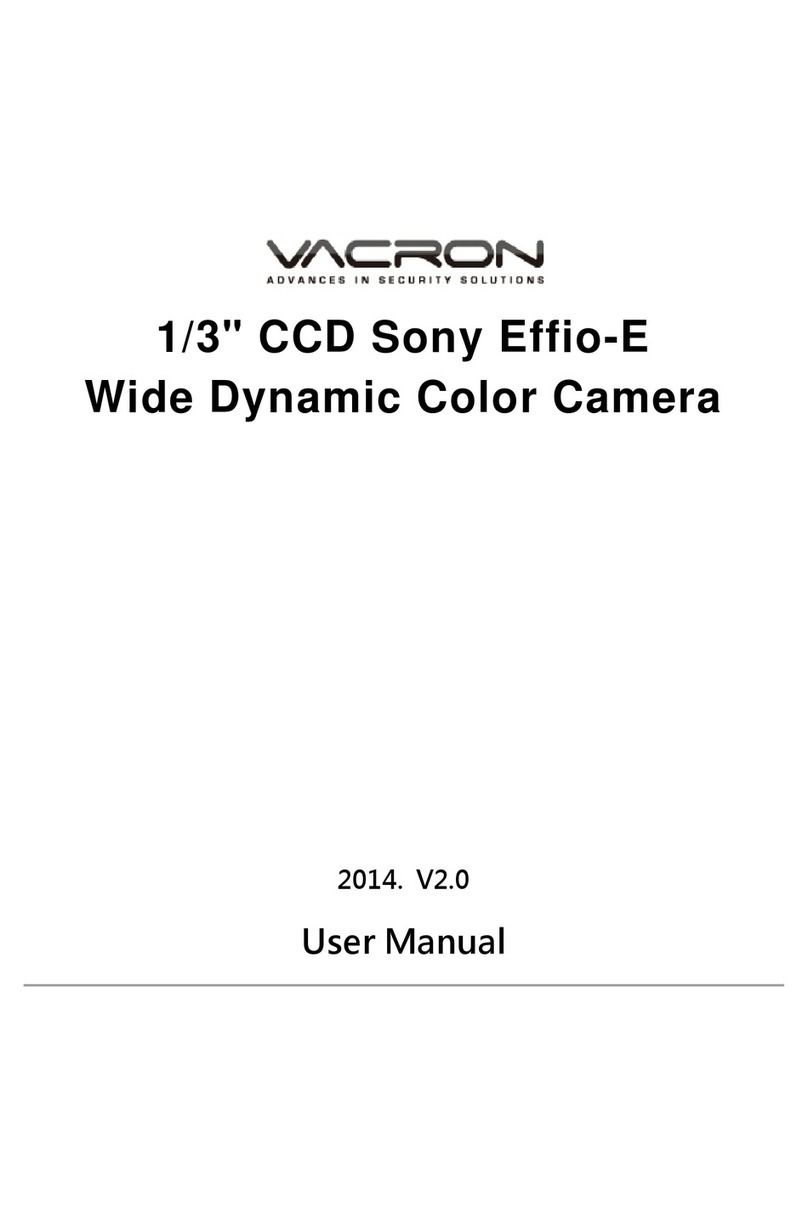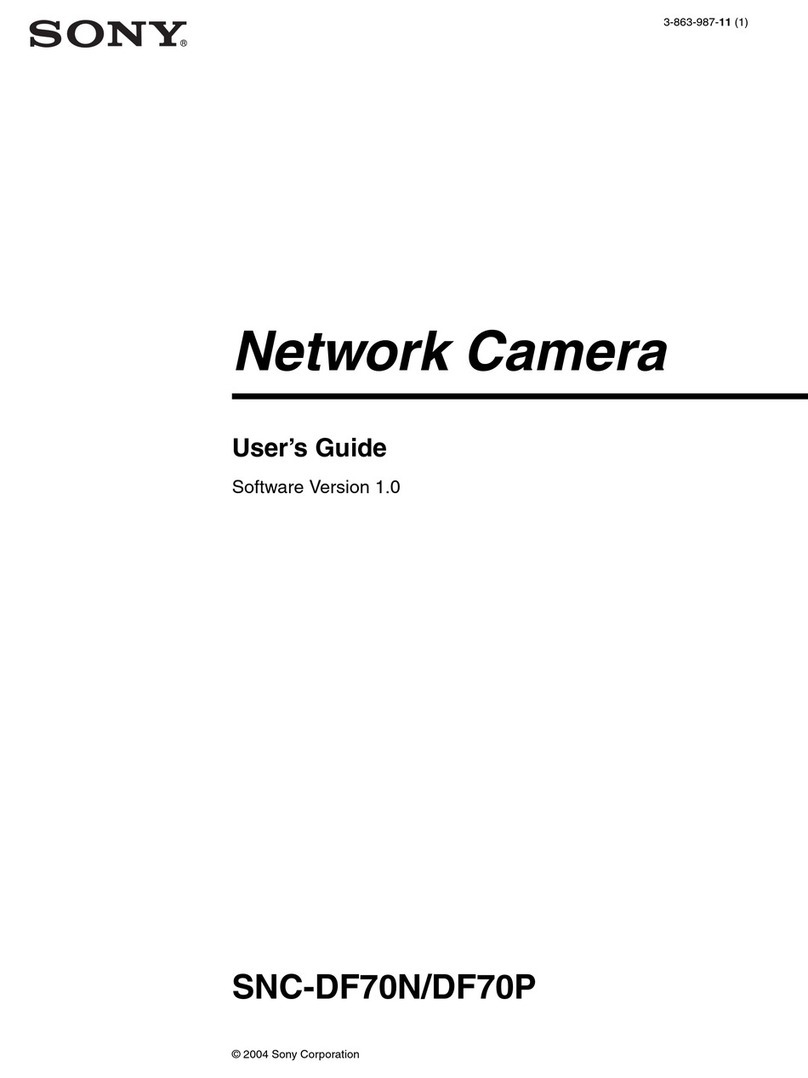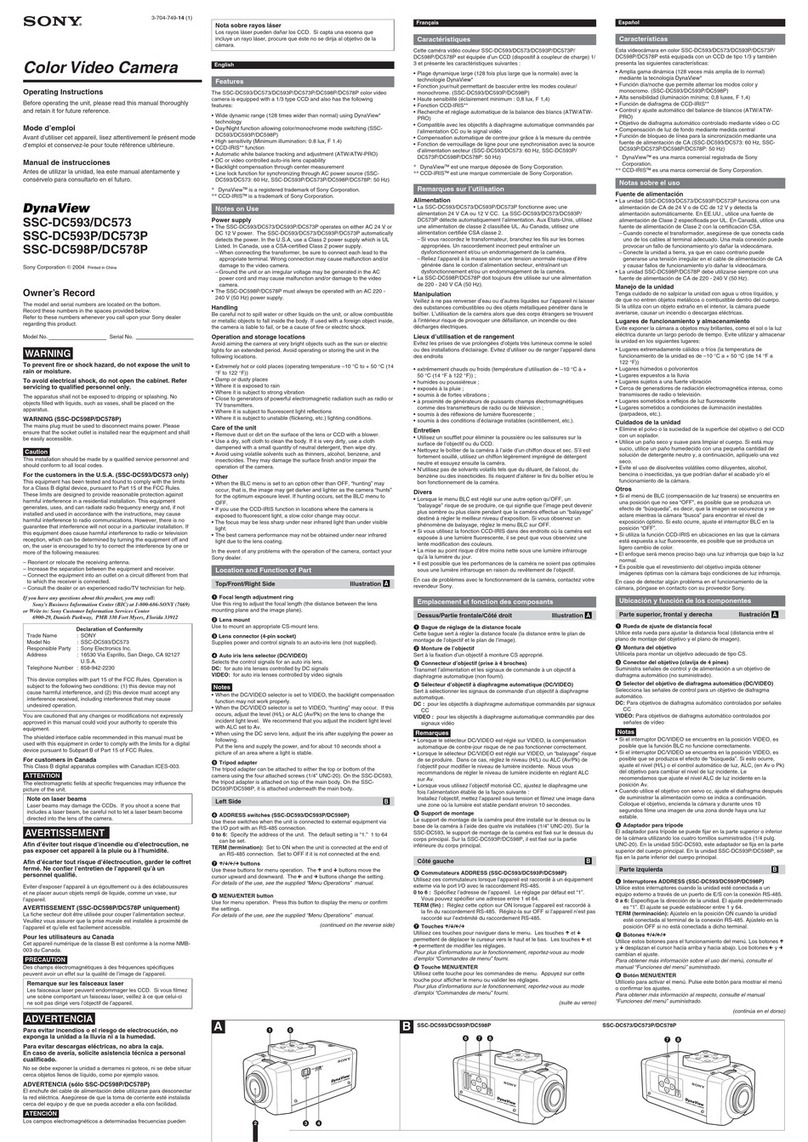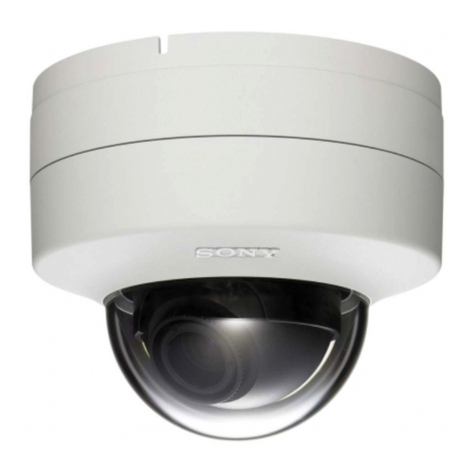
English
Installation
Before Installation
After deciding the direction in which the camera will shoot, make the
required hole (ø 58 to 72 mm (2 3/8to 2 7/8inches) ) for the connecting
cables using the supplied template. Then decide the four mounting hole
positions to install the bracket. (D)
Installing on the wall
When you install the camera on a wall lengthwise, position the side
conduit hole directly below to prevent moisture from getting inside the
casing. (E)
Mounting screws
The supplied bracket is provided with eight ø 4.5 mm ( 3/16 inch) mounting
holes. Install the bracket on a ceiling or wall with screws through these
four of the eight holes.
The required mounting screws differ depending on the installation location
and its material. (Mounting screws are not supplied.)
Steel wall or ceiling: Use M4 bolts and nuts.
Wood wall or ceiling: Use the supplied M4 tapping screws. The panel
thickness must be 15 mm ( 5/8inch) or more.
Concrete wall: Use appropriate anchors, bolts and plugs for concrete
walls.
Junction box: Use screws to match the holes on the junction box.
WARNING
The required mounting screws differ depending on the installation location
and its material. If you do not secure the camera with the appropriate
mounting screws, the camera may fall off.
Installing the Camera
1Remove the dome casing.
Loosen the three dome casing screws with the supplied wrench, and
remove the dome casing.
2Remove the slit cover.
Remove it expanding the slit cover. (F)
3Check the conduit of the cables.
The cables are set up at the factory to pass through the bottom conduit
hole. If you want to use the side conduit hole, perform the following
steps:
1Remove the conduit hole cover.
2Disconnect the cables from the connectors, and pull them out from
the bottom conduit hole.
3Insert the cables through the side conduit hole, and connect the
cables to their respective connectors.
4Attach the conduit hole cover that was removed from the side
conduit hole to the bottom conduit hole.
Notes
• If the bottom conduit hole is dirty, the conduit hole cover cannot be
fixed firmly. In this case, moisture may leak into the casing and this
may cause a malfunction. Wipe off the dust with a soft cloth, and fix
the conduit hole cover firmly.
•Cover the joint part of the pipe/cover with silicon sealant, etc. to
prevent moisture from getting inside the casing.
•Use a pipe/plug with a thread length of 12 mm (1/2in.) or less so that
it does not damage the camera. (G)
4Connect the D/N cable.
When you make Day/Night function active, feed the supplied D/N
cable through the conduit hole, and connect it to the D/N cable
connector of the camera unit. Then, secure it with the cable clamp.
5Install the supplied bracket on the ceiling or wall. (H)
Refer to “Mounting screws” for screws to be used.
6When installing on a ceiling or wall, fix the supplied wire rope to the
camera and the ceiling or wall. (I)
1There are two screw holes for wire rope on the bottom of the
camera. Fix the wire rope with the supplied shoulder screw as
required.
2Fix the wire rope to the ceiling or wall.
7Attach the camera unit to the bracket with the supplied mounting
screws. (I)
Turn the camera unit to click and fix one of the projections on the
bottom of the camera to the positioning hole of the bracket. There are
four projections with an angle of 90 degrees, so you can select one of
four directions.
WARNING
• If you want to install the camera at a height such as on a ceiling,
entrust the installation to an experienced contractor or installer.
•If you install the camera at a height, ensure that the installation
location and its material are strong enough to withstand a weight of
20 kg (44 lb 1 oz) or more, and then install the camera securely. If
they are not strong enough, the camera may fall and cause serious
injury.
• To prevent the camera from falling, be sure to attach the supplied
wire rope.
•If you install the camera at a height, check periodically, at least once
a year, to ensure that the connection has not loosened. If conditions
warrant, perform this periodic check more frequently.
Note
If you cannot use screws on a ceiling or wall, or if you want to make
the camera less conspicuous, use the YT-ICB45 in-ceiling bracket
(optional) with which you can mount the camera on the ceiling.
Adjusting the Camera Direction and Coverage
J
1Loosen the camera head fixing screw.
2Adjust the camera to turn the lens in the desired direction.
3Tighten the camera head fixing screw to fix the camera.
4Loosen the lens ring fixing screw.
5Turn the zoom ring to adjust the angle of view.
6Turn the focus ring to adjust the focus.
7Tighten the lens ring fixing screw to fix the zoom and the focus.
8Repeat steps 1to 7until the coverage and the focus are determined.
Notes
• When you adjust the camera head angle without loosening camera
head fixing screw, an internal metallic part may be damaged.
•If the camera head is too heavy to be adjusted, loosen the camera
head fixing screw until it moves freely.
• When the lens is not put in the slit of the camera head holder, the
moving range of the camera head is limited.
•Do not turn the lens more than 360 degrees. As this may damage
the wiring inside.
•There are three screw holes for fixing the lens ring at 120 degree
intervals. If the lens ring fixing screw poses a problem for adjusting
the camera direction and coverage due to the direction of the
camera head, detach the screw and reattach it to another screw
hole, then adjust the camera direction and coverage again.
• When adjusting the angle, be sure that the TOP mark on the camera
head section faces the ceiling. If the camera is installed with the
TOP mark facing the floor, the image appears upside down.
2Fix the dome casing and the camera unit.
Align the three screw holes on the dome casing with those on the
camera unit, and tighten the screws with the supplied wrench to
secure the dome casing and unit casing.
Typical CCD Phenomena
The following phenomena may appear on the monitor screen while you
are using a CCD color video camera. These phenomena stem from the
high sensitivity of the CCD image sensors, and do not indicate a fault
within the camera.
Vertical smear
A “smear” may appear to extend vertically from very bright subjects, as
shown below.
This phenomenon is common to CCD imaging elements using an interline
transfer system, and is caused when electric charge induced by infrared
radiation deep within the photo sensor is transferred to the resistors.
Aliasing
When shooting fine stripes, straight lines or similar patterns, the lines may
become slightly jagged.
Blemishes
A CCD image sensor consists of an array of individual picture elements
(pixels). A malfunctioning sensor element will show up
as a single pixel blemish in the image. This is generally not a problem.
White speckles
When you shoot a poorly illuminated object at a high temperature, small
white dots may appear all over the entire screen image.
Specifications
Image device 1/3 type interline transfer (SuperExwave)
Effective picture elements 752 (horizontal) ×582 (vertical)
Focal length 2.8 to 10 mm
Maximum relative aperture
F1.3
View angle Horizontal: 100.8° (wide) – 27.7° (tele)
Vertical: 73.9° (wide) – 20.8° (tele)
Minimum object distance
0.3 m
Signal system PAL color system
Synchronization system Internal (DC 12 V/AC 24 V)/
Line lock (AC 24 V only) switchable
Horizontal resolution 540 TV lines
Minimum illumination Color: 0.6 lx, F1.3, 50 IRE
0.35 lx, F1.3, 30 IRE
Black & White: 0.06 lx, F1.3, 50 IRE
0.05 lx, F1.3, 30 IRE
Video output 1.0 Vp-p, 75 ohms, negative sync, BNC cable
Video S/N ratio More than 50 dB (AGC OFF)
White balance ATW/ATW Pro switchable
AGC ON / OFF switchable
BLC ON / OFF switchable
Monitor output Phono jack
Power supply 24 V AC ±10 % / 50Hz, 12 V DC ±10 %
(Automatically switched)
Power consumption 4 W max.
16 W with the optional YT-HU75 Heater Unit
Operating temperature –20 °C to +50 °C (–4 °F to +122 °F)
Storage temperature –40 °C to +60 °C (–40 °F to +140 °F)
Operating humidity 20% to 80%
Storage humidity 20% to 95%
Dimensions (diameter/height) (L)
177.5 ×141.5 mm
(7 ×5 5/8inches)
Mass Approx. 1.75 kg (3 lb 14 oz)
Supplied accessories
Wrench (1), D/N cable (1), Installation screw (4),
Shoulder screw M4 (1), Wire rope (1),
Template (1), Operating Instructions (1)
Optional accessories In-ceiling bracket YT-ICB45
Heater unit YT-HU75
Design and specifications are subject to change without notice.
Always verify that the unit is operating properly before use. SONY WILL
NOT BE LIABLE FOR DAMAGES OF ANY KIND INCLUDING, BUT NOT
LIMITED TO, COMPENSATION OR REIMBURSEMENT ON ACCOUNT
OF THE LOSS OF PRESENT OR PROSPECTIVE PROFITS DUE TO
FAILURE OF THIS UNIT, EITHER DURING THE WARRANTY PERIOD
OR AFTER EXPIRATION OF THE WARRANTY, OR FOR ANY OTHER
REASON WHATSOEVER.
Regular parts replacement
Some of the parts that make up this product (electrolytic condenser, for
example) need replacing regularly depending on their life expectancies.
The lives of parts differ according to the environment or condition in
which this product is used and the length of time it is used, so we
recommend regular checks.
Consult the dealer from whom you bought it for details.
Video monitor screen Pale vertical smear
Very bright subject (such as
an electric lamp,
fluorescent lamp, sunlight,
or strong reflected light)
D
E
F
I
J
12mm (1/2in.) or less/
G
H
Wire rope
Positioning
Hole/
K
Slit cover/
Bracket/
Ceiling/
Projection/
1, 3
2
4, 7
5
6
Unit: mm (inches)/
85.7 (3 3/8)
46 (1 13/16)
85.7 (3
3
/
8
)
83.5 (3
9
/
32
)
LBottom/
Unit: mm (inches)/
ø177.5 (7)
141.5 (5
5
/
8
)
Side/
Conduit hole (3/4in.)/
Ceiling/
Position the conduit hole
directly below./
Wire rope/
Lens ring fixing
screw holes/
Hole for the
connecting cables
ø58 to 72
(2 3/8to 2 7/8)/
Hole for
installing the
bracket/
Horizontal
marker/
Vertical marker/
典型 CCD 现象
当您使用 CCD 彩色摄像机时,监视器屏幕上可能会出现以下现象。这些现
象主要由于 CCD 图像传感器的高灵敏度造成的,并不是摄像机的故障。
垂直拖影
如下所示,在非常亮的物体上可能会出现垂直延长的“拖影”。
此现象对于使用隔行传送系统的 CCD 成像元件很常见,当光电传感器中由
红外线辐射产生的电荷传送到电阻时,会产生这种现象。
图形失真
当拍摄精细条纹、直线或类似图案时,这些线条可能会稍稍出现锯齿状。
疵点
CCD 图像传感器由一列单个的图像元素(像素)组成。出现故障的一个传
感器元素将会显示为图像中的单个像素疵点。一般来说这不是什么故障。
白色斑点
当您在高温下拍摄一个亮度很小的物体时,整个屏幕图像上可能会布满小
白点。
视频监视器屏幕 白色垂直拖影
非常明亮的物体(如电灯、荧
光灯、日光或强烈反射光)
产品中有毒有害物质或元素的名称及含量
使用环境条件:参考使用手册中的操作条件
○:
表示该有毒有害物质在该部件所有均质材料中的含量均在
SJ/T11363-2006 标准规定的限量要求以下。
×:
表示该有毒有害物质至少在该部件的某一均质材料中的含量超出
SJ/T11363-2006 标准规定的限量要求。
有毒有害物质或元素
铅
(Pb)
汞
(Hg)
镉
(Cd)
六价铬
(Cr (VI))
多溴联苯
(PBB)
多溴二苯醚
(PBDE)
实装基板 × ○ ○ ○ ○ ○
外壳 × ○ ○ ○ ○ ○
光学组件 × ○ ○ ○ ○ ○
附属品 × ○ ○ ○ ○ ○
部件名称
Attaching the Dome Casing K
1Attach the slit cover.
Notes
• The proper position of the slit cover is slightly apart from the camera
mount. Do not push in by force.
• If you cannot attach the slit cover because the barrier of the lens
ring fixing screw prevents it, attach the lens ring fixing screw to
another screw hole. There are three screw holes for the lens ring
fixing screw on the concentric circle.
制 造 商 上海索广映像有限公司
地 址 上海市浦东新区川沙路 3777 号
企业标准编号 Q/YXSJ467-2008
出版日期:2008年9月
